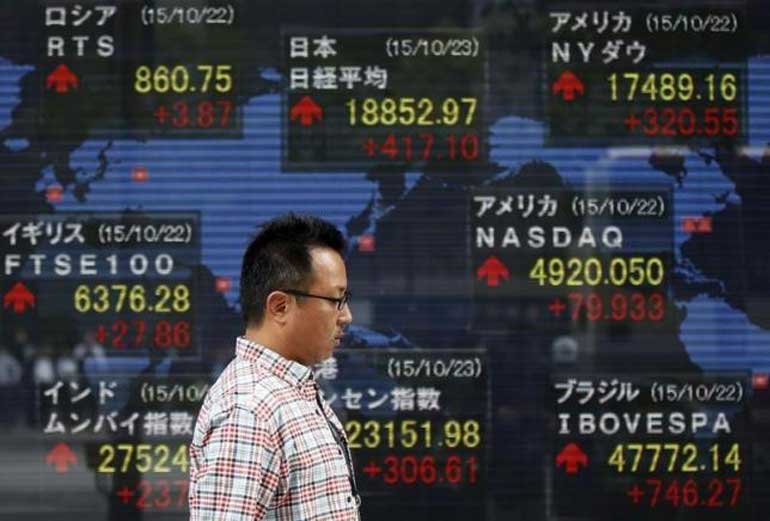Thursday Feb 13, 2025
Thursday Feb 13, 2025
Thursday, 10 December 2015 00:00 - - {{hitsCtrl.values.hits}}
 A man walks past an electronic board showing the stock market indices of various countries outside a brokerage in Tokyo, Japan- REUTERS
A man walks past an electronic board showing the stock market indices of various countries outside a brokerage in Tokyo, Japan- REUTERS
Reuters: Asian stock markets risked slipping to two-month lows on Wednesday as crumbling oil prices took a toll on energy and resource shares, with cooling demand from China putting more pressure on resources-reliant economies.
MSCI’s broadest index of Asia-Pacific shares outside Japan was flat but stood barely above its November trough, a break of which would take it to its lowest level since early October.
Japan’s Nikkei shed 0.6% to hit a three-week low.
Overnight on Wall Street, the S&P 500 .SPX lost 0.7%, with the S&P energy sector .SPNY falling 1.5% in its fifth straight day of declines. The sector has fallen 10.4% since 1 December.
The Organisation of Petroleum Exporting Countries’ decision on Friday not to cut its production target has rattled commodity traders, sparking concerns global oil producers will pump even more crude into an already oversupplied market. That has shaken up oil prices, which is wobbling near seven-year lows hit on Tuesday.
Brent futures LCOc1 fell 1.2% in overnight trade to settle at $ 40.26 per barrel, after hitting a low at $ 39.81, the first time it fell below $ 40 since February 2009. They have fallen almost 30% so far this year after a fall of nearly 50% in 2014.
US benchmark West Texas Intermediate (WTI) futures sunk to as low as $ 36.64 earlier CLc1 on Tuesday and last stood at $ 38.12.
“The fall is driven by likely increases in supply after the OPEC meeting and as Iran will return to the market after a lift of sanctions. On the other hand, demand doesn’t look strong as many economies face downside risk,” said Shuji Shirota, head of macro economics strategy at HSBC Securities.
“At the moment, it is hard to see where a bottom will be.”
Soft trade data from China on Tuesday cemented concerns over cooling demand from the world’s second largest economy.
Still, analysts say opportunistic Chinese buyers may have merely been taking advantage of a fresh slump in commodity prices, and will likely continue to export large quantities of finished products such as steel and diesel fuel because demand is not strong enough at home.
China’s inflation data due later in the day will provide another gauge on the strength of domestic demand.
With oil prices hovering below breakeven levels for many producers, investors are trying to cut exposures to the sector, hitting countries that depend on revenues from oil and other resources.
MSCI’s gauge of emerging market shares fell to two-month lows.
On Tuesday, Brazilian shares edged near their six-year low touched earlier this year while shares in Qatar fell 3.1% to a two-year low and Dubai shares also came close to a one-year low touched December last year.
Investors have another reason to be cautious on risk assets as the US Federal Reserve is widely expected to raise interest rates for the first time in almost a decade next week.
That prospect has provided broad support to the dollar, but currency traders are starting to wonder if the Fed liftoff is already fully priced in.
The dollar soared against oil-linked currencies on Tuesday, touching an 11-year high against the Canadian dollar CAD=D3 and a 13-year high versus the Norwegian crown NOK=, but its performance wasn’t as stellar against other major rivals.
The euro traded at $ 1.0894 EUR=, maintaining its 0.5% gains on Tuesday, and edging back towards a one-month high of $ 1.0981 hit on Thursday after the European Central Bank’s stimulus turned out to be smaller than expected.
The dollar also edged back against the yen to 122.80 yen JPY= from this week’s high of 123.48 yen, turning negative on the week.
Discover Kapruka, the leading online shopping platform in Sri Lanka, where you can conveniently send Gifts and Flowers to your loved ones for any event including Valentine ’s Day. Explore a wide range of popular Shopping Categories on Kapruka, including Toys, Groceries, Electronics, Birthday Cakes, Fruits, Chocolates, Flower Bouquets, Clothing, Watches, Lingerie, Gift Sets and Jewellery. Also if you’re interested in selling with Kapruka, Partner Central by Kapruka is the best solution to start with. Moreover, through Kapruka Global Shop, you can also enjoy the convenience of purchasing products from renowned platforms like Amazon and eBay and have them delivered to Sri Lanka.
Discover Kapruka, the leading online shopping platform in Sri Lanka, where you can conveniently send Gifts and Flowers to your loved ones for any event including Valentine ’s Day. Explore a wide range of popular Shopping Categories on Kapruka, including Toys, Groceries, Electronics, Birthday Cakes, Fruits, Chocolates, Flower Bouquets, Clothing, Watches, Lingerie, Gift Sets and Jewellery. Also if you’re interested in selling with Kapruka, Partner Central by Kapruka is the best solution to start with. Moreover, through Kapruka Global Shop, you can also enjoy the convenience of purchasing products from renowned platforms like Amazon and eBay and have them delivered to Sri Lanka.